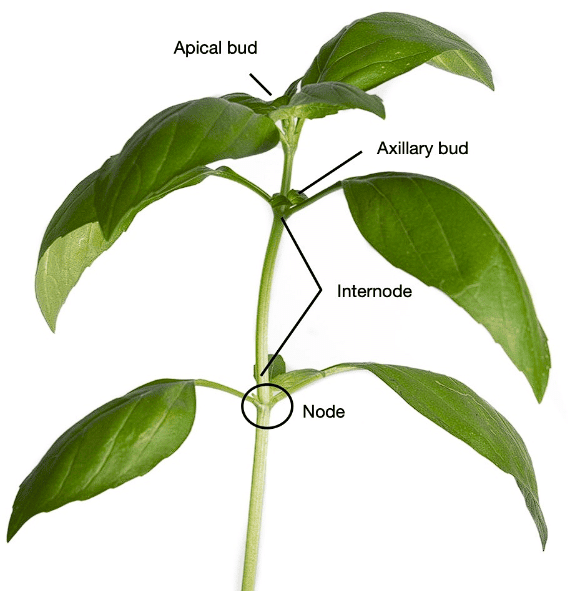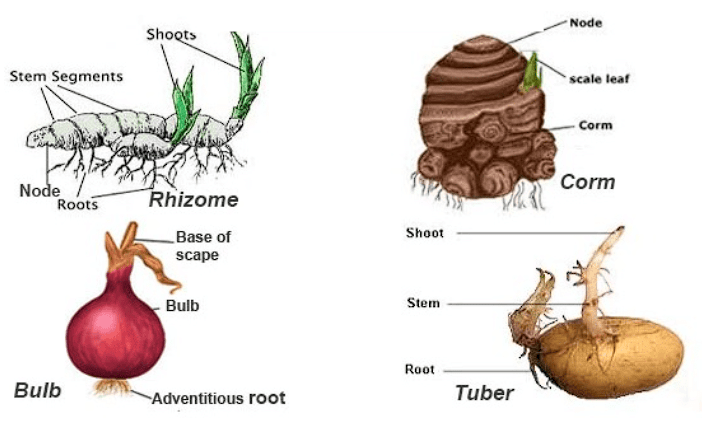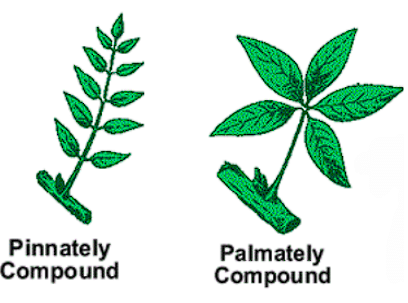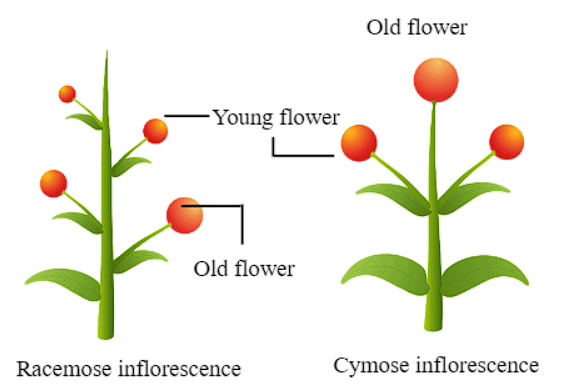The Stem and Leaf: Structures and Modifications | Biology Class 11 - NEET PDF Download
| Table of contents |

|
| What is a Stem? |

|
| Modifications of Stem |

|
| The Leaf |

|
| Types of Leaves |

|
| Modifications of Leaves |

|
| The Inflorescence |

|
What is a Stem?
The stem is the upward-growing part of the plant axis that supports branches, leaves, flowers, and fruits. It develops from the plumule of the germinating seed.
Regions of Stem
- Nodes and Internodes: Nodes are the regions on the stem where leaves are attached, while internodes are the sections of the stem between two nodes.
- Buds: The stem bears buds, which can be terminal (at the tip of the stem) or axillary (located in the leaf axil).
- Young vs. Mature Stems: Young stems are generally green, while older stems often become woody and dark brown.
 Structure of Stem
Structure of Stem
Functions of Stem
- Support: The stem provides support to the plant by holding up the leaves, flowers, and fruits.
- Transport: The stem transports water, minerals, and food substances (photosynthates) between the roots and other parts of the plant.
- Storage: Some stems can store food for the plant.
- Protection: The stem can offer protection to the plant, especially in certain types of stems that have thorns or other protective features.
- Vegetative Propagation: In some plants, the stem can help in reproducing new plants (vegetative propagation).
Modifications of Stem
- Stems can be modified to perform different functions that may not be typical. For example, underground stems of plants like potatoes, ginger, turmeric, zaminkand, and Colocasia are modified to store food. These stems also help the plant survive during unfavorable growth conditions.
- Stem tendrils develop from axillary buds and are slender, spirally coiled structures that help plants climb. Examples include plants in the gourd family (like cucumber, pumpkin, and watermelon) and grapevines.
- In some plants, axillary buds modify into thorns, which are woody, straight, and pointed. Thorns protect plants from animals that might eat them, and are found in plants like Citrus and Bougainvillea.
- Plants in arid regions may modify their stems into flattened(like Opuntia) or fleshy cylindrical(like Euphorbia) structures to adapt to their environment.
 Modifications of Stem
Modifications of Stem
- Plants with chlorophyll can perform photosynthesis to create their own food. Some plants, like grass and strawberries, have underground stems that spread to new areas. When the older parts die, new plants are formed from these underground stems.
- In plants such as mint and jasmine, a thin lateral branch grows from the base of the main stem. This branch initially grows upwards and then bends down to touch the ground, allowing it to take root and grow into a new plant.
- Aquatic plants like Pistia and Eichhornia have lateral branches with short internodes. Each node on these branches produces a rosette of leaves and a tuft of roots, helping the plant to spread in water.
- In banana,pineapple, and Chrysanthemum, lateral branches emerge from the basal and underground parts of the main stem. These branches grow horizontally beneath the soil and then rise obliquely upward, producing leafy shoots.
The Leaf
A leaf is a flat structure that grows out from the stem. It develops at a point on the stem called a node and has a small bud in its armpit (the angle between the leaf and the stem). This bud can grow into a new branch later on.
- Leaves come from the tips of the plant's shoots and are arranged in a way that the newest leaves are at the top.
- Leaves are very important for the plants because they are the main parts that carry out photosynthesis, the process by which plants make their food using sunlight.
Parts of Leaf
- A typical leaf has three main parts: leaf base, petiole, and lamina.
- The leaf base attaches the leaf to the stem and may have small structures called stipules on either side.

- In monocotyledons, the leaf base forms a sheath that covers the stem.
- In some leguminous plants, the leaf base can swell to form a pulvinus.
- The petiole holds the leaf blade in place and can be long and flexible, allowing the leaf to move in the wind. This movement helps cool the leaf and brings fresh air to its surface.
- The lamina, or leaf blade, is the green, expanded part of the leaf. It has a midrib, which is the main vein running down the center, and smaller veins that provide rigidity and transport water, minerals, and food.
- The shape, margin, apex, surface, and degree of incision of the lamina can vary widely between different types of leaves.
Venation
Venation refers to the pattern of veins and veinlets in a leaf's lamina.
Types of venation
(a) When the veinlets create a network, it is called reticulate venation.
(b) When the veins run parallel to each other, it is known as parallel venation.
Note: Dicotyledonous plants commonly have reticulate venation, while most monocotyledons exhibit parallel venation.
 Types of Venation
Types of Venation
Types of Leaves
- Simple Leaf: A leaf is considered simple when its lamina is whole (entire) or when it has incisions that do not reach the midrib. In a simple leaf, the incisions are shallow and do not divide the leaf into smaller parts.
- Compound Leaf: A leaf is classified as a compound when the incisions of the lamina extend to the midrib, effectively breaking the leaf into multiple smaller sections called leaflets. In this case, the leaf is divided into several distinct parts, all attached to the same central midrib.
- Bud Location: In both simple and compound leaves, a bud is found in the axil of the petiole (the stalk that attaches the leaf to the stem). However, in compound leaves, there is no bud in the axil of the individual leaflets. This means that while the main leaf has a bud at its base, the smaller leaflets do not have this feature.
Types of Compound Leaves
 Types of Compound Leaf
Types of Compound Leaf
- Pinnately Compound Leaves: In this type, multiple leaflets are attached along a common axis called the rachis, which acts like the midrib of the leaf. An example of this is the neem tree.
- Palmately Compound Leaves: Here, all the leaflets converge at a single point at the tip of the petiole, similar to the way fingers spread out from the palm of a hand. The silk cotton tree is an example of this type of leaf.
Phyllotaxy
The arrangement pattern of leaves on a stem or branch. There are three main types of phyllotaxy: alternate, opposite, and whorled.
- Alternate phyllotaxy involves a single leaf emerging at each node in an alternating manner. Examples include plants like china rose, mustard, and sunflower.
- Opposite phyllotaxy occurs when a pair of leaves arises at each node, positioned directly opposite to each other. Plants such as calotropis and guava exhibit this type.
- Whorled phyllotaxy is when more than two leaves emerge at a single node, forming a whorl. An example of this is the alstonia plant.
Modifications of Leaves
Leaves can be modified to perform various functions beyond photosynthesis:

- Tendrils: In plants like peas, leaves are transformed into tendrils that help the plant climb.
- Spines: Cacti have modified leaves in the form of spines, which serve as a defense mechanism.
- Fleshy Leaves: Onions and garlic have thick, fleshy leaves that store food.
- Petiole Modification: In some plants like the Australian acacia, the leaves are small and short-lived. However, the petioles (the stalks that attach the leaf to the stem) expand, turn green, and take on the role of photosynthesis.
- Insectivorous Plants: Certain plants, such as the pitcher plant and the Venus flytrap, have leaves that are modified to catch and digest insects.
The Inflorescence
A flower is like a special version of a shoot. In a flower, the tip of the shoot changes from making regular leaves to making floral parts. When the tip of a shoot turns into a flower, it usually happens as a single flower, not a bunch. The way flowers are arranged on the shoot is called inflorescence.

- There are two main types of inflorescences, depending on what happens at the tip of the shoot:
- Racemose: Here, the shoot tip keeps growing, and flowers are added along the sides in a top-to-bottom order (younger flowers at the bottom, older ones at the top).
- Cymose: In this type, the shoot tip ends with a flower, which stops further upward growth. Flowers are added in a bottom-to-top order (older flowers at the bottom, younger ones at the top).
|
150 videos|399 docs|136 tests
|
FAQs on The Stem and Leaf: Structures and Modifications - Biology Class 11 - NEET
| 1. What is the primary function of a stem in plants? |  |
| 2. What are some common modifications of stems? |  |
| 3. How do leaves contribute to a plant's survival? |  |
| 4. What are the different types of leaves found in plants? |  |
| 5. Can you explain some modifications of leaves and their functions? |  |
















